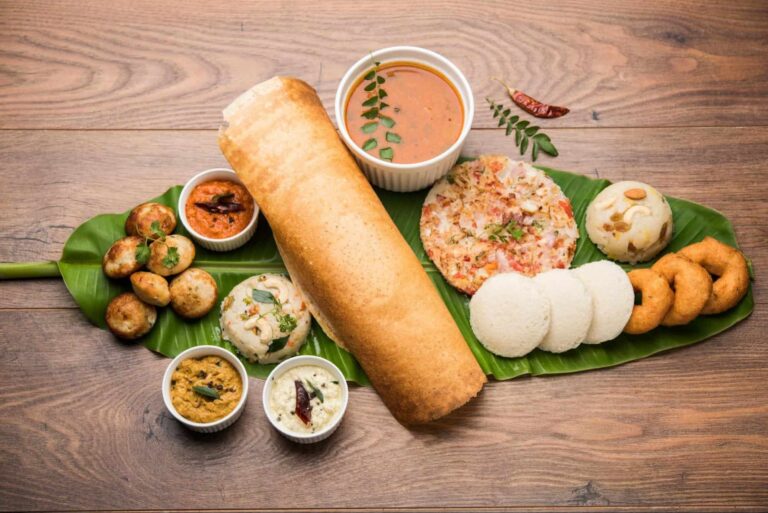
Indian cuisine is incredibly diverse, with each region offering its own unique flavors, ingredients, and cooking techniques. Among the most distinct culinary divisions in the country is the difference between North Indian and South Indian food. While both share a deep love for spices and bold flavors, they vary significantly in staple ingredients, preparation methods, and even dining traditions.
Staple Ingredients: Wheat vs. Rice
One of the most noticeable differences between North and South Indian cuisine is the choice of staple grain. North Indian food relies heavily on wheat-based dishes like roti, naan, paratha, and kulcha, which are commonly served with rich curries and lentil-based dishes. South Indian cuisine, on the other hand, is centered around rice. Dosa, idli, uttapam, and curd rice are everyday staples, often accompanied by coconut chutney and sambar. While rice is eaten across India, North Indian cuisine incorporates it mainly in dishes like biryani and pulao, whereas in South India, it is a part of almost every meal.
Flavor Profiles and Use of Spices
Both North and South Indian cuisines use a variety of spices, but the flavor profiles are quite distinct. North Indian food is known for its rich, creamy textures and aromatic spices such as garam masala, cardamom, cinnamon, and kasuri methi. Popular dishes like butter chicken, dal makhani, and paneer tikka masala reflect these flavors. The use of dairy products like ghee, cream, and yogurt also plays a significant role in making the curries thick and flavorful.
South Indian cuisine, by contrast, is spicier, tangier, and has a strong emphasis on coconut and tamarind. The food is often seasoned with mustard seeds, curry leaves, dried red chilies, and asafoetida. Sambar and rasam are prime examples of South Indian dishes that balance heat with tanginess. Unlike North Indian food, which uses yogurt for creaminess, South Indian curries tend to have coconut milk or ground coconut for a distinct taste.
Cooking Oils and Techniques
Another key difference lies in the choice of cooking oil. In North India, ghee and mustard oil are commonly used, adding a rich and indulgent flavor to dishes. The cuisine also features a lot of tandoori cooking, with dishes like tandoori chicken and kebabs prepared in clay ovens.
South Indian food, on the other hand, makes use of coconut oil and sesame oil, which give the dishes a unique aroma. Steaming and tempering techniques are widely used, particularly for dishes like idli, dosa, and upma. The process of tempering—where mustard seeds, curry leaves, and chilies are fried in hot oil and added to the dish—is a signature aspect of South Indian cooking.
Popular Dishes in North and South India
Both North and South Indian cuisines offer an extensive variety of dishes. Here’s how some of their most famous foods compare:
North Indian Dishes
- Breads: Naan, roti, paratha, kulcha
- Curries: Butter chicken, dal makhani, paneer tikka masala
- Rice Dishes: Biryani, pulao, jeera rice
- Snacks: Samosa, chole bhature, kachori
- Desserts: Gulab jamun, gajar ka halwa, rasmalai
South Indian Dishes
- Breads: Dosa, appam, pesarattu
- Curries: Sambar, rasam, kootu, avial
- Rice Dishes: Curd rice, lemon rice, tamarind rice
- Snacks: Medu vada, idli, mysore bonda
- Desserts: Payasam, mysore pak, coconut barfi
Eating Style and Presentation
The way food is served and eaten also varies between the two regions. North Indian meals are usually served on plates with separate bowls for dal, sabzi, and curries, along with bread or rice. South Indian meals, especially traditional ones, are often served on banana leaves. The arrangement of the food is also different, with rice placed at the center and various accompaniments arranged around it.
Another distinct cultural practice in South India is the tradition of eating with hands, which is believed to enhance the dining experience by mixing flavors more effectively. While this practice exists in North India as well, it is more prevalent in the South.
Which Cuisine is Better?
The answer depends entirely on personal preference. North Indian cuisine is perfect for those who enjoy creamy, rich gravies and wheat-based dishes, while South Indian cuisine is ideal for those who prefer spicy, tangy flavors and rice-heavy meals. Both offer an incredible range of flavors and dishes, making Indian cuisine one of the most diverse in the world.
Instead of choosing one over the other, the best way to experience Indian food is to enjoy both North and South Indian specialties. Whether it’s a plate of butter naan with dal makhani or a crispy dosa with coconut chutney, each meal offers a unique and delicious experience.


